Modification of Thin Film Composite PVA/PAN Membranes for Pervaporation Using Aluminosilicate Nanoparticles
Abstract
:1. Introduction
2. Results and Discussion
2.1. Average Size and Zeta Potential of Aluminosilicate Nanoparticles in PVA Aqueous Solution
2.2. Scanning Electron Microscopy
2.3. Atomic Force Microscopy
2.4. Contact Angle
2.5. Membrane Performance
3. Materials and Methods
3.1. Materials
3.2. Methods
3.2.1. Synthesis of Al2O3·SiO2 Hydrosol
3.2.2. Preparation of PVA Aqueous Solutions and PVA-Al2O3·SiO2 Dispersion
3.2.3. Preparation of PVA-Al2O3·SiO2/PAN TFN Membranes
3.2.4. Scanning Electron Microscopy
3.2.5. Atomic Force Microscopy
3.2.6. Water Contact Angle Measurements
3.2.7. Pervaporation Experiments
4. Conclusions
Author Contributions
Funding
Institutional Review Board Statement
Informed Consent Statement
Data Availability Statement
Conflicts of Interest
References
- Zentou, H.; Abidin, Z.Z.; Yunus, R.; Awang Biak, D.R.; Abdullah Issa, M.; Yahaya Pudza, M. Modelling of Mass Transfer during Pervaporation of Ethanol/Water Mixture Using Polydimethylsiloxane Membrane. Chem. Eng. Res. Des. 2021, 175, 320–329. [Google Scholar] [CrossRef]
- Zhang, Z.; Ruan, F.; Xu, S.; Wu, W.; Shi, S.; Xiao, G. Pervaporation Separation of N, N-Dimethylformamide/Water Using Poly (Vinyl Alcohol) Based Mixed Matrix Membranes. Process Saf. Environ. Prot. 2022, 159, 779–794. [Google Scholar] [CrossRef]
- Castro-Muñoz, R.; Buera-González, J.; de la Iglesia, Ó.; Galiano, F.; Fíla, V.; Malankowska, M.; Rubio, C.; Figoli, A.; Téllez, C.; Coronas, J. Towards the Dehydration of Ethanol Using Pervaporation Cross-Linked Poly(Vinyl Alcohol)/Graphene Oxide Membranes. J. Membr. Sci. 2019, 582, 423–434. [Google Scholar] [CrossRef] [Green Version]
- Xiong, Y.; Deng, N.; Wu, X.; Zhang, Q.; Liu, S.; Sun, G. De Novo Synthesis of Amino-Functionalized ZIF-8 Nanoparticles: Enhanced Interfacial Compatibility and Pervaporation Performance in Mixed Matrix Membranes Applying for Ethanol Dehydration. Sep. Purif. Technol. 2022, 285, 120321. [Google Scholar] [CrossRef]
- Dudek, G.; Gnus, M.; Turczyn, R.; Strzelewicz, A.; Krasowska, M. Pervaporation with Chitosan Membranes Containing Iron Oxide Nanoparticles. Sep. Purif. Technol. 2014, 133, 8–15. [Google Scholar] [CrossRef]
- Kuzminova, A.I.; Dmitrenko, M.E.; Poloneeva, D.Y.; Selyutin, A.A.; Mazur, A.S.; Emeline, A.V.; Mikhailovskii, V.Y.; Solovyev, N.D.; Ermakov, S.S.; Penkova, A.V. Sustainable Composite Pervaporation Membranes Based on Sodium Alginate Modified by Metal Organic Frameworks for Dehydration of Isopropanol. J. Membr. Sci. 2021, 626, 119194. [Google Scholar] [CrossRef]
- Cheng, C.; Li, P.; Zhang, T.; Wang, X.; Hsiao, B.S. Enhanced Pervaporation Performance of Polyamide Membrane with Synergistic Effect of Porous Nanofibrous Support and Trace Graphene Oxide Lamellae. Chem. Eng. Sci. 2019, 196, 265–276. [Google Scholar] [CrossRef]
- Penkova, A.V.; Dmitrenko, M.E.; Ermakov, S.S.; Toikka, A.M.; Roizard, D. Novel Green PVA-Fullerenol Mixed Matrix Supported Membranes for Separating Water-THF Mixtures by Pervaporation. Environ. Sci. Pollut. Res. 2018, 25, 20354–20362. [Google Scholar] [CrossRef]
- Zhao, D.; Li, M.; Jia, M.; Zhou, S.; Zhao, Y.; Peng, W.; Xing, W. Asymmetric Poly (Vinyl Alcohol)/Schiff Base Network Framework Hybrid Pervaporation Membranes for Ethanol Dehydration. Eur. Polym. J. 2022, 162, 110924. [Google Scholar] [CrossRef]
- Li, P.; Shen, K.; Zhang, T.; Ding, S.; Wang, X. High-Performance Polyamide Composite Membranes via Double-Interfacial Polymerizations on a Nanofibrous Substrate for Pervaporation Dehydration. Sep. Purif. Technol. 2021, 257, 117927. [Google Scholar] [CrossRef]
- Grushevenko, E.A.; Borisov, I.L.; Knyazeva, A.A.; Volkov, V.V.; Volkov, A.V. Polyalkylmethylsiloxanes Composite Membranes for Hydrocarbon/Methane Separation: Eight Component Mixed-Gas Permeation Properties. Sep. Purif. Technol. 2020, 241, 116696. [Google Scholar] [CrossRef]
- Liang, Y.; Ma, H.; Taha, A.A.; Hsiao, B.S. High-Flux Anti-Fouling Nanofibrous Composite Ultrafiltration Membranes Containing Negatively Charged Water Channels. J. Membr. Sci. 2020, 612, 118382. [Google Scholar] [CrossRef]
- Feng, Q.; Zhan, Y.; Yang, W.; Dong, H.; Sun, A.; Liu, Y.; Wen, X.; Chiao, Y.-H.; Zhang, S. Layer-by-Layer Construction of Super-Hydrophilic and Self-Healing Polyvinylidene Fluoride Composite Membrane for Efficient Oil/Water Emulsion Separation. Colloids Surf. A Physicochem. Eng. Asp. 2021, 629, 127462. [Google Scholar] [CrossRef]
- Prapainainar, P.; Du, Z.; Theampetch, A.; Prapainainar, C.; Kongkachuichay, P.; Holmes, S.M. Properties and DMFC Performance of Nafion/Mordenite Composite Membrane Fabricated by Solution-Casting Method with Different Solvent Ratio. Energy 2020, 190, 116451. [Google Scholar] [CrossRef]
- Yang, Y.; Fu, W.; Chen, L.; Hou, C.; Chen, X.; Zhang, X. One-Step Dip-Coating Method for Preparation of Ceramic Nanofiber Membrane with High Permeability and Low Cost. J. Eur. Ceram. Soc. 2021, 41, 358–368. [Google Scholar] [CrossRef]
- Chen, S.; Gao, J.; Yan, E.; Wang, Y.; Li, Y.; Lu, H.; Fan, L.; Wang, D.; An, Q. A Novel Porous Composite Membrane of PHA/PVA via Coupling of Electrospinning and Spin Coating for Antibacterial Applications. Mater. Lett. 2021, 301, 130279. [Google Scholar] [CrossRef]
- Jiang, X.; Chuah, C.Y.; Goh, K.; Wang, R. A Facile Direct Spray-Coating of Pebax® 1657: Towards Large-Scale Thin-Film Composite Membranes for Efficient CO2/N2 Separation. J. Membr. Sci. 2021, 638, 119708. [Google Scholar] [CrossRef]
- Xu, H.; Feng, W.; Sheng, M.; Yuan, Y.; Wang, B.; Wang, J.; Wang, Z. Covalent Organic Frameworks-Incorporated Thin Film Composite Membranes Prepared by Interfacial Polymerization for Efficient CO2 Separation. Chin. J. Chem. Eng. 2022, 43, 152–160. [Google Scholar] [CrossRef]
- Guo, J.; Zhang, G.; Wu, W.; Ji, S.; Qin, Z.; Liu, Z. Dynamically Formed Inner Skin Hollow Fiber Polydimethylsiloxane/Polysulfone Composite Membrane for Alcohol Permselective Pervaporation. Chem. Eng. J. 2010, 158, 558–565. [Google Scholar] [CrossRef]
- Burts, K.S.; Plisko, T.V.; Prozorovich, V.G.; Melnikova, G.B.; Ivanets, A.I.; Bildyukevich, A.V. Development and Study of PVA–SiO2/Poly(AN-Co-MA) Dynamic Nanocomposite Membranes for Ethanol Dehydration via Pervaporation. Membr. Membr. Technol. 2022, 4, 101–110. [Google Scholar] [CrossRef]
- Burts, K.S.; Plisko, T.V.; Bildyukevich, A.V.; Li, G.; Kujawa, J.; Kujawski, W. Development of Dynamic PVA/PAN Membranes for Pervaporation: Correlation between Kinetics of Gel Layer Formation, Preparation Conditions, and Separation Performance. Chem. Eng. Res. Des. 2022, 182, 544–557. [Google Scholar] [CrossRef]
- Zhang, G.; Gao, X.; Ji, S.; Liu, Z. One-Step Dynamic Assembly of Polyelectrolyte Complex Membranes. Mater. Sci. Eng. C 2009, 29, 1877–1884. [Google Scholar] [CrossRef]
- Na, L.; Zhongzhou, L.; Shuguang, X. Dynamically Formed Poly (Vinyl Alcohol) Ultrafiltration Membranes with Good Anti-Fouling Characteristics. J. Membr. Sci. 2000, 169, 17–28. [Google Scholar] [CrossRef]
- Kochan, J.; Wintgens, T.; Wong, J.E.; Melin, T. Properties of Polyethersulfone Ultrafiltration Membranes Modified by Polyelectrolytes. Desalination 2010, 250, 1008–1010. [Google Scholar] [CrossRef]
- Ji, S.; Zhang, G.; Liu, Z.; Peng, Y.; Wang, Z. Evaluations of Polyelectrolyte Multilayer Membranes Assembled by a Dynamic Layer-by-Layer Technique. Desalination 2008, 234, 300–306. [Google Scholar] [CrossRef]
- Liu, C.; Shi, L.; Wang, R. Enhanced Hollow Fiber Membrane Performance via Semi-Dynamic Layer-by-Layer Polyelectrolyte Inner Surface Deposition for Nanofiltration and Forward Osmosis Applications. React. Funct. Polym. 2015, 86, 154–160. [Google Scholar] [CrossRef]
- Dahlheimer, J.A.; Thomas, D.G.; Kraus, K.A. Hyperfiltration. Application of Woven Fiber Hoses to Hyperfiltration of Salts and Crossflow Filtration of Suspended Solids. Ind. Eng. Chem. Proc. Des. Dev. 1970, 9, 566–569. [Google Scholar] [CrossRef]
- Akamatsu, K.; Okuyama, M.; Mitsumori, K.; Yoshino, A.; Nakao, A.; Nakao, S. Effect of the Composition of the Copolymer of Carboxybetaine and N-Butylmethacrylate on Low-Fouling Property of Dynamically Formed Membrane. Sep. Purif. Technol. 2013, 118, 463–469. [Google Scholar] [CrossRef]
- Ba, C.; Ladner, D.A.; Economy, J. Using Polyelectrolyte Coatings to Improve Fouling Resistance of a Positively Charged Nanofiltration Membrane. J. Membr. Sci. 2010, 347, 250–259. [Google Scholar] [CrossRef]
- Kryvoruchko, A.P.; Atamanenko, I.D.; Yurlova, L.Y. Concentration/Purification of Co(II) Ions by Reverse Osmosis and Ultrafiltration Combined with Sorption on Clay Mineral Montmorillonite and Cation-Exchange Resin KU-2-8n. J. Membr. Sci. 2004, 228, 77–81. [Google Scholar] [CrossRef]
- Borisov, I.L.; Kujawska, A.; Knozowska, K.; Volkov, V.V.; Kujawski, W. Influence of Feed Flow Rate, Temperature and Feed Concentration on Concentration Polarization Effects during Separation of Water-Methyl Acetate Solutions with High Permeable Hydrophobic Pervaporation PDMS Membrane. J. Membr. Sci. 2018, 564, 1–9. [Google Scholar] [CrossRef]
- Qiu, B.; Wang, Y.; Fan, S.; Liu, J.; Jian, S.; Qin, Y.; Xiao, Z.; Tang, X.; Wang, W. Ethanol Mass Transfer during Pervaporation with PDMS Membrane Based on Solution-Diffusion Model Considering Concentration Polarization. Sep. Purif. Technol. 2019, 220, 276–282. [Google Scholar] [CrossRef]
- Liu, Y.; Tong, Z.; Zhu, H.; Zhao, X.; Du, J.; Zhang, B. Polyamide Composite Membranes Sandwiched with Modified Carbon Nanotubes for High Throughput Pervaporation Desalination of Hypersaline Solutions. J. Membr. Sci. 2022, 641, 119889. [Google Scholar] [CrossRef]
- Halakoo, E.; Feng, X. Self-Assembled Membranes from Polyethylenimine and Graphene Oxide for Pervaporation Dehydration of Ethylene Glycol. J. Membr. Sci. 2020, 616, 118583. [Google Scholar] [CrossRef]
- Wu, G.; Fan, Q.; Sun, W.; Yu, Z.; Jia, Z.; Ma, J. Regulatable Pervaporation Performance of Zn-MOFs/Polydimethylsiloxane Mixed Matrix Pervaporation Membranes. Chin. J. Chem. Eng. 2022, 42, 312–318. [Google Scholar] [CrossRef]
- Cao, C.; Wang, H.; Wang, M.; Liu, Y.; Zhang, Z.; Liang, S.; Yuhan, W.; Pan, F.; Jiang, Z. Conferring Efficient Alcohol Dehydration to Covalent Organic Framework Membranes via Post-Synthetic Linker Exchange. J. Membr. Sci. 2021, 630, 119319. [Google Scholar] [CrossRef]
- Penkova, A.V.; Acquah, S.F.; Piotrovskiy, L.B.; Markelov, D.A.; Semisalova, A.S.; Kroto, H.W. Fullerene Derivatives as Nano-Additives in Polymer Composites. Russ. Chem. Rev. 2017, 86, 530–566. [Google Scholar] [CrossRef]
- Cao, T.; Li, J.; Li, C.; Zhang, N.; Cai, P.; Wang, N.; An, Q.-F. POSS-Graphene Oxide Nanocomposite Membranes for Ethanol Permselective Pervaporation. Micropor. Mesopor. Mat. 2022, 331, 111635. [Google Scholar] [CrossRef]
- Lee, J.-Y.; Zhan, J.-Y.; Ang, M.B.M.Y.; Yeh, S.-C.; Tsai, H.-A.; Jeng, R.-J. Improved Performance of Nanocomposite Polyimide Membranes for Pervaporation Fabricated by Embedding Spirobisindane Structure-Functionalized Graphene Oxide. Sep. Purif. Technol. 2021, 265, 118470. [Google Scholar] [CrossRef]
- Liu, G.; Jiang, Z.; Li, C.; Hou, L.; Chen, C.; Yang, H.; Pan, F.; Wu, H.; Zhang, P.; Cao, X. Layer-by-Layer Self-Assembled Nanocomposite Membranes via Bio-Inspired Mineralization for Pervaporation Dehydration. J. Membr. Sci. 2019, 570–571, 44–52. [Google Scholar] [CrossRef]
- Gao, R.; Zhang, Q.; Lv, R.; Soyekwo, F.; Zhu, A.; Liu, Q. Highly Efficient Polymer–MOF Nanocomposite Membrane for Pervaporation Separation of Water/Methanol/MTBE Ternary Mixture. Chem. Eng. Res. Des. 2017, 117, 688–697. [Google Scholar] [CrossRef]
- Wang, J.; Li, M.; Zhou, S.; Xue, A.; Zhang, Y.; Zhao, Y.; Zhong, J.; Zhang, Q. Graphitic Carbon Nitride Nanosheets Embedded in Poly(Vinyl Alcohol) Nanocomposite Membranes for Ethanol Dehydration via Pervaporation. Sep. Purif. Technol. 2017, 188, 24–37. [Google Scholar] [CrossRef]
- Lin, W.; Zhu, T.; Li, Q.; Yi, S.; Li, Y. Study of Pervaporation for Dehydration of Caprolactam through PVA/Nano Silica Composite Membranes. Desalination 2012, 285, 39–45. [Google Scholar] [CrossRef]
- Çalhan, A.; Deniz, S.; Kujawski, W.; Kujawa, J.; Knozowska, K.; Hasanoğlu, A. Silica Filled Polyphenylsulfone/Polydimethylsiloxane Composite Membranes for Pervaporation Separation of Biobutanol from ABE Mixtures. Chem. Eng. Process. 2020, 156, 108099. [Google Scholar] [CrossRef]
- Liu, Y.-L.; Hsu, C.-Y.; Su, Y.-H.; Lai, J.-Y. Chitosan−Silica Complex Membranes from Sulfonic Acid Functionalized Silica Nanoparticles for Pervaporation Dehydration of Ethanol−Water Solutions. Biomacromolecules 2005, 6, 368–373. [Google Scholar] [CrossRef]
- Lopes, A.C.; Martins, P.; Lanceros-Mendez, S. Aluminosilicate and Aluminosilicate Based Polymer Composites: Present Status, Applications and Future Trends. Prog. Surf. Sci. 2014, 89, 239–277. [Google Scholar] [CrossRef]
- Simanjuntak, W.; Sembiring, S.; Manurung, P.; Situmeang, R.; Low, I.M. Characteristics of Aluminosilicates Prepared from Rice Husk Silica and Aluminum Metal. Ceram. Int. 2013, 39, 9369–9375. [Google Scholar] [CrossRef] [Green Version]
- Zou, Y.; Hu, Y.; Shen, Z.; Yao, L.; Tang, D.; Zhang, S.; Wang, S.; Hu, B.; Zhao, G.; Wang, X. Application of Aluminosilicate Clay Mineral-Based Composites in Photocatalysis. J. Environ. Sci. 2022, 115, 190–214. [Google Scholar] [CrossRef]
- Islam, M.A.; Morton, D.W.; Johnson, B.B.; Pramanik, B.K.; Mainali, B.; Angove, M.J. Metal Ion and Contaminant Sorption onto Aluminium Oxide-Based Materials: A Review and Future Research. J. Environ. Chem. Eng. 2018, 6, 6853–6869. [Google Scholar] [CrossRef]
- Baldermann, A.; Preissegger, V.; Šimić, S.; Letofsky-Papst, I.; Mittermayr, F.; Dietzel, M. Uptake of Aqueous Heavy Metal Ions (Co2+, Cu2+ and Zn2+) by Calcium-Aluminium-Silicate-Hydrate Gels. Cem. Concr. Res. 2021, 147, 106521. [Google Scholar] [CrossRef]
- Zhang, T.; Zhang, J.; Wang, Q.; Zhang, H.; Wang, Z.; Wu, Z. Evaluating of the Performance of Natural Mineral Vermiculite Modified PVDF Membrane for Oil/Water Separation by Membrane Fouling Model and XDLVO Theory. J. Membr. Sci. 2022, 641, 119886. [Google Scholar] [CrossRef]
- Baroña, G.N.B.; Choi, M.; Jung, B. High Permeate Flux of PVA/PSf Thin Film Composite Nanofiltration Membrane with Aluminosilicate Single-Walled Nanotubes. J. Colloid Interface Sci. 2012, 386, 189–197. [Google Scholar] [CrossRef] [PubMed]
- Asempour, F.; Akbari, S.; Bai, D.; Emadzadeh, D.; Matsuura, T.; Kruczek, B. Improvement of Stability and Performance of Functionalized Halloysite Nano Tubes-Based Thin Film Nanocomposite Membranes. J. Membr. Sci. 2018, 563, 470–480. [Google Scholar] [CrossRef]
- Baroña, G.N.B.; Lim, J.; Choi, M.; Jung, B. Interfacial Polymerization of Polyamide-Aluminosilicate SWNT Nanocomposite Membranes for Reverse Osmosis. Desalination 2013, 325, 138–147. [Google Scholar] [CrossRef] [Green Version]
- Veerapur, R.; Gudasi, K.; Aminabhavi, T. Sodium Alginate–Magnesium Aluminum Silicate Mixed Matrix Membranes for Pervaporation Separation of Water–Isopropanol Mixtures. Sep. Purif. Technol. 2008, 59, 221–230. [Google Scholar] [CrossRef]
- Kang, D.-Y.; Tong, H.M.; Zang, J.; Choudhury, R.P.; Sholl, D.S.; Beckham, H.W.; Jones, C.W.; Nair, S. Single-Walled Aluminosilicate Nanotube/Poly(Vinyl Alcohol) Nanocomposite Membranes. ACS Appl. Mater. Interfaces 2012, 4, 965–976. [Google Scholar] [CrossRef]
- Singha, N.R.; Parya, T.K.; Ray, S.K. Dehydration of 1,4-Dioxane by Pervaporation Using Filled and Crosslinked Polyvinyl Alcohol Membrane. J. Membr. Sci. 2009, 340, 35–44. [Google Scholar] [CrossRef]
- Achari, D.D.; Hegde, S.N.; Pattanashetti, N.A.; Kamble, R.R.; Kariduraganavar, M.Y. Development of Zeolite-A Incorporated PVA/CS Nanofibrous Composite Membranes Using the Electrospinning Technique for Pervaporation Dehydration of Water/Tert -Butanol. New J. Chem. 2021, 45, 3981–3996. [Google Scholar] [CrossRef]
- Meenakshi, S.; Sahu, A.K.; Bhat, S.D.; Sridhar, P.; Pitchumani, S.; Shukla, A.K. Mesostructured-Aluminosilicate-Nafion Hybrid Membranes for Direct Methanol Fuel Cells. Electrochim. Acta 2013, 89, 35–44. [Google Scholar] [CrossRef]
- Cui, Y.; Liu, Y.; Wu, J.; Zhang, F.; Baker, A.P.; Lavorgna, M.; Wu, Q.; Tang, Q.; Lu, J.; Xiao, Z.; et al. Porous Silicon-Aluminium Oxide Particles Functionalized with Acid Moieties: An Innovative Filler for Enhanced Nafion-Based Membranes of Direct Methanol Fuel Cell. J. Power Sources 2018, 403, 118–126. [Google Scholar] [CrossRef]
- Kang, D.-Y.; Zang, J.; Wright, E.R.; McCanna, A.L.; Jones, C.W.; Nair, S. Dehydration, Dehydroxylation, and Rehydroxylation of Single-Walled Aluminosilicate Nanotubes. ACS Nano 2010, 4, 4897–4907. [Google Scholar] [CrossRef] [PubMed]
- Al-Gharabli, S.; Al-Omari, B.; Kujawski, W.; Kujawa, J. How Can the Desert Beetle and Biowaste Inspire Hybrid Separation Materials for Water Desalination? ACS Appl. Mater. Interfaces 2021, 13, 11268–11283. [Google Scholar] [CrossRef] [PubMed]
- Kujawa, J.; Kujawski, W. Functionalization of Ceramic Metal Oxide Powders and Ceramic Membranes by Perfluoroalkylsilanes and Alkylsilanes Possessing Different Reactive Groups: Physicochemical and Tribological Properties. ACS Appl. Mater. Interfaces 2016, 8, 7509–7521. [Google Scholar] [CrossRef] [PubMed]
- Flynn, E.J.; Keane, D.A.; Tabari, P.M.; Morris, M.A. Pervaporation Performance Enhancement through the Incorporation of Mesoporous Silica Spheres into PVA Membranes. Sep. Purif. Technol. 2013, 118, 73–80. [Google Scholar] [CrossRef]
- Sairam, M.; Naidu, B.V.K.; Nataraj, S.K.; Sreedhar, B.; Aminabhavi, T.M. Poly(Vinyl Alcohol)-Iron Oxide Nanocomposite Membranes for Pervaporation Dehydration of Isopropanol, 1,4-Dioxane and Tetrahydrofuran. J. Membr. Sci. 2006, 283, 65–73. [Google Scholar] [CrossRef]
- Ivanets, A.I.; Azarova, T.A.; Agabekov, V.E.; Azarov, S.M.; Batsukh, C.; Batsuren, D.; Prozorovich, V.G.; Rat’ko, A.A. Effect of Phase Composition of Natural Quartz Raw Material on Characterization of Microfiltration Ceramic Membranes. Ceram. Int. 2016, 42, 16571–16578. [Google Scholar] [CrossRef]
- Ivanets, A.I.; Rat’ko, A.I.; Azarova, T.A.; Azarov, S.M.; Al-Khowaiter, S.H.; Al-Harbi, O.; Shemchonok, S.V.; Dobysh, V.A.; Tarasevich, V.A.; Agabekov, V.E.; et al. Preparation and Properties of Microfiltration Membranes Based on Natural Crystalline SiO2. Ceram. Int. 2014, 40, 12343–12351. [Google Scholar] [CrossRef]
- Selim, A.; Knozowska, K.; Ośmiałowski, B.; Kujawa, J.; Mizsey, P.; Kujawski, W. The Fabrication, Characterization, and Pervaporation Performance of Poly(Ether-Block-Amide) Membranes Blended with 4-(Trifluoromethyl)-N(Pyridine-2-Yl)Benzamide and 4-(Dimethylamino)-N(Pyridine-2-Yl)Benzamide Fillers. Sep. Purif. Technol. 2021, 268, 118707. [Google Scholar] [CrossRef]
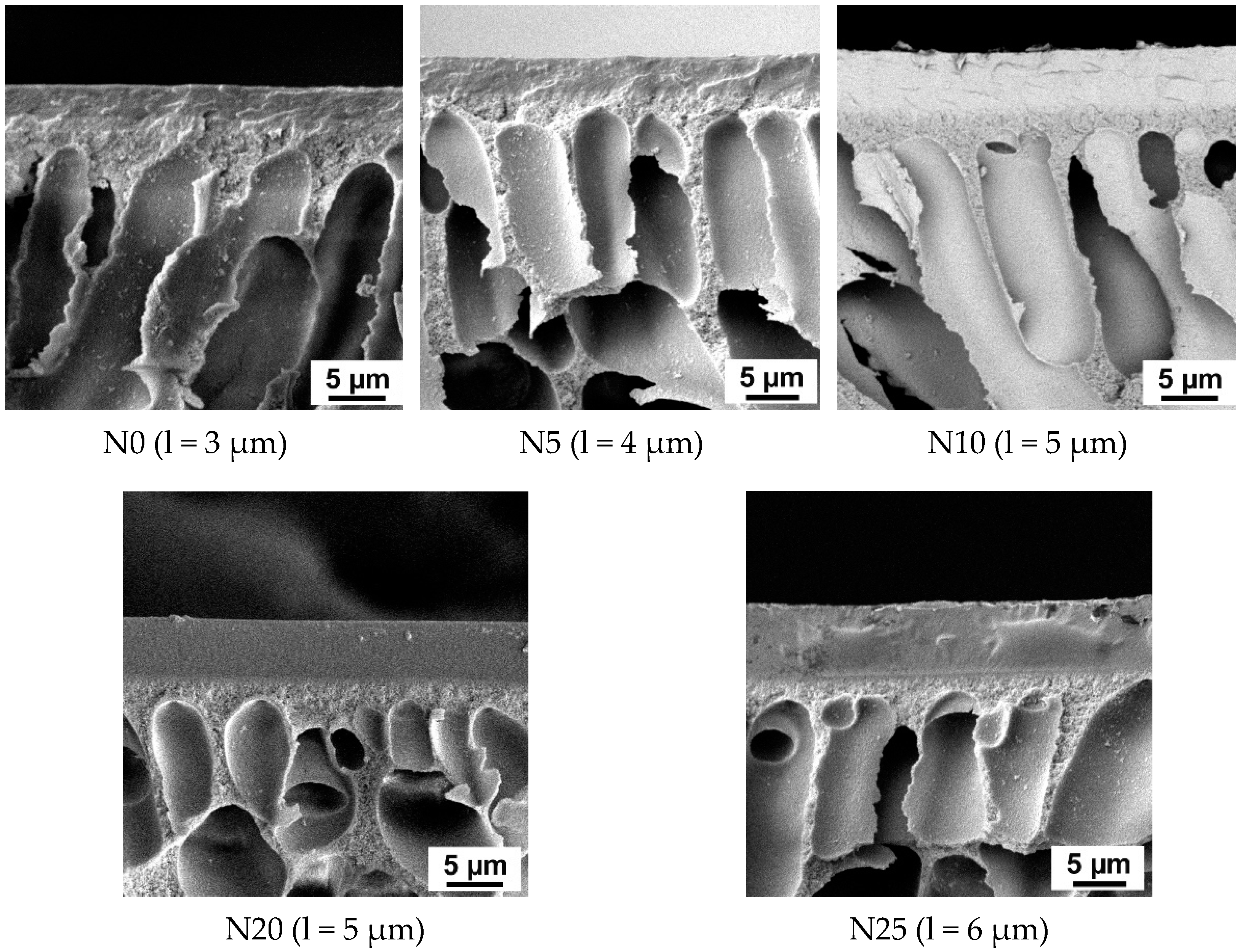
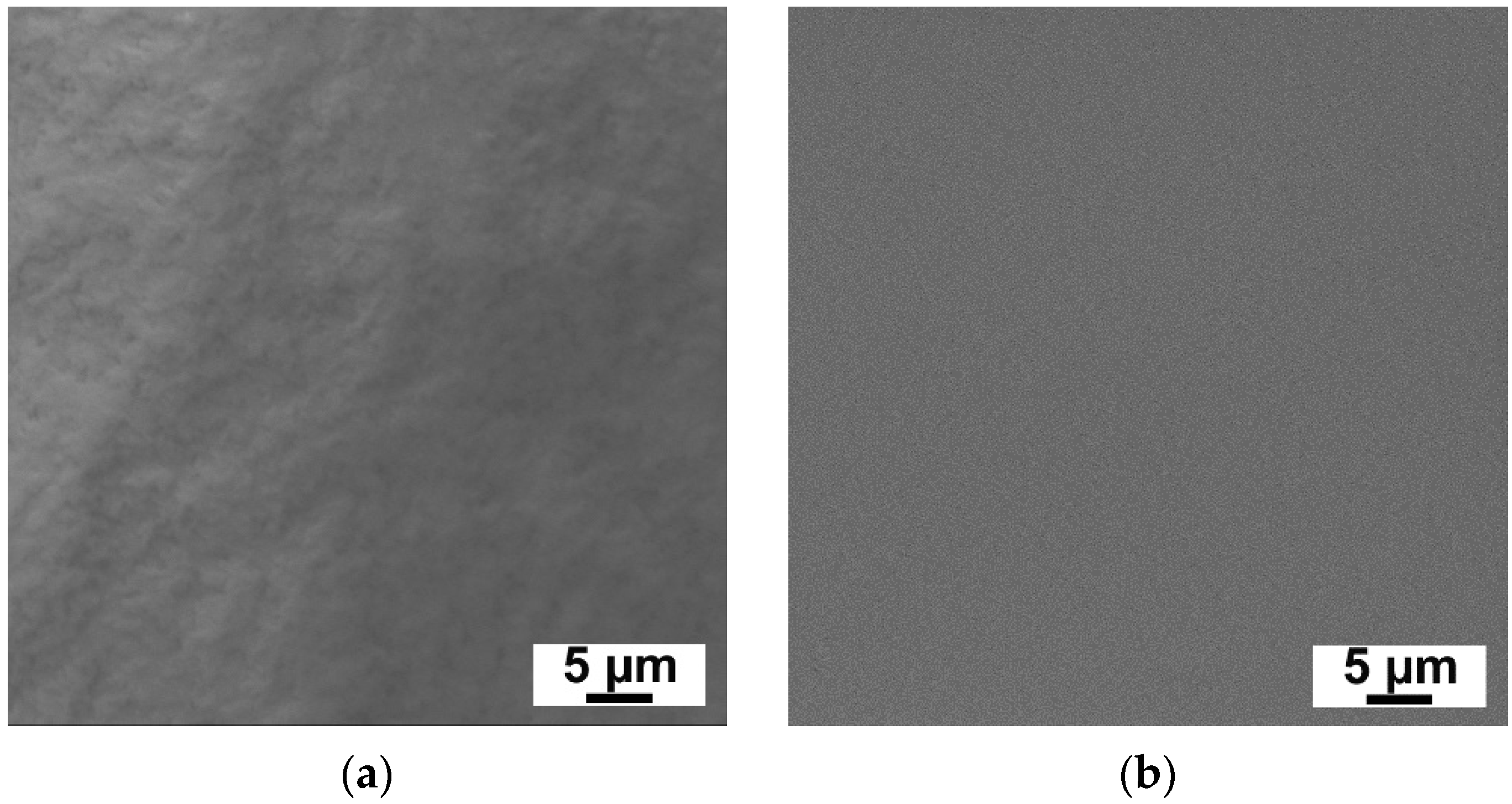
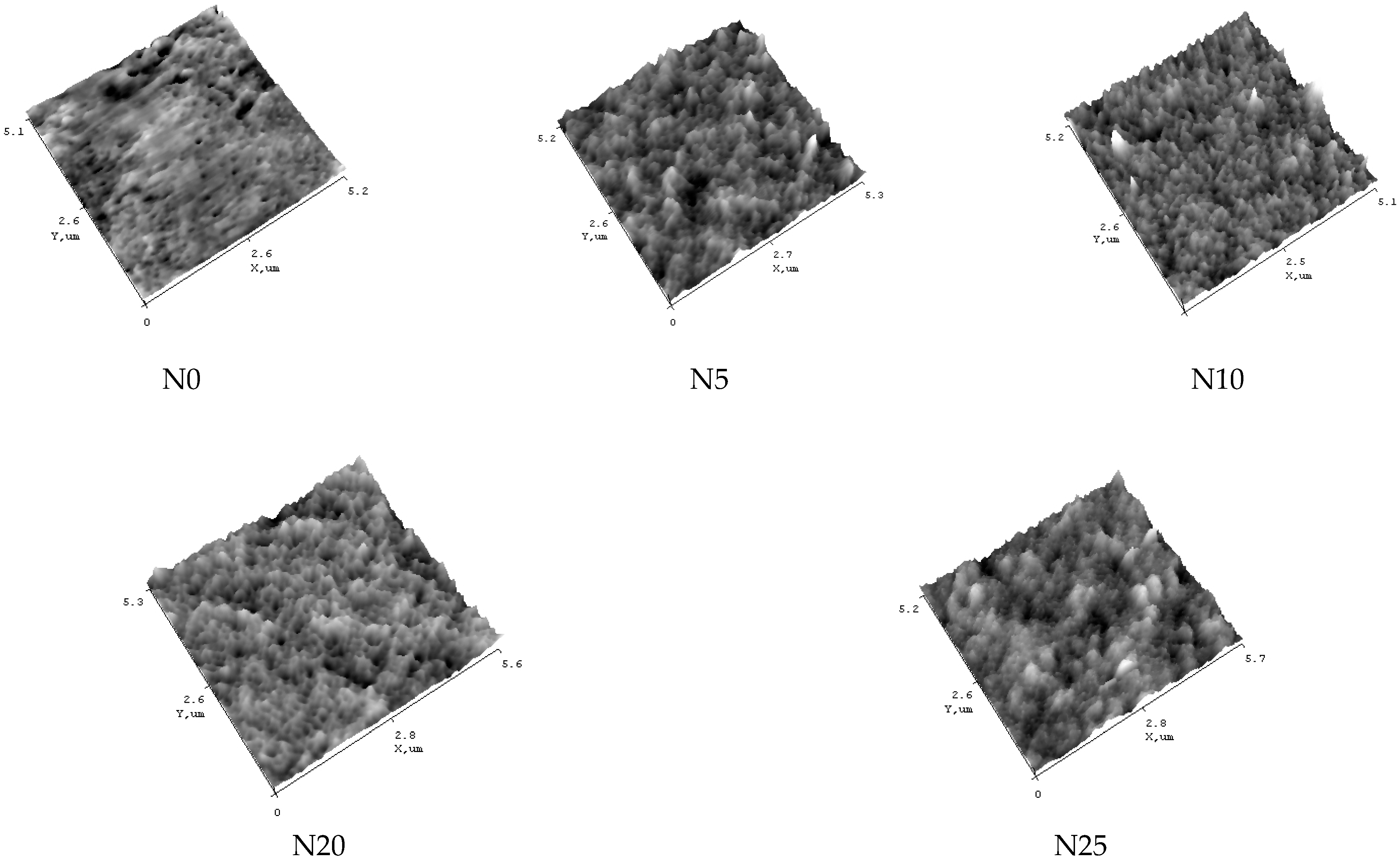
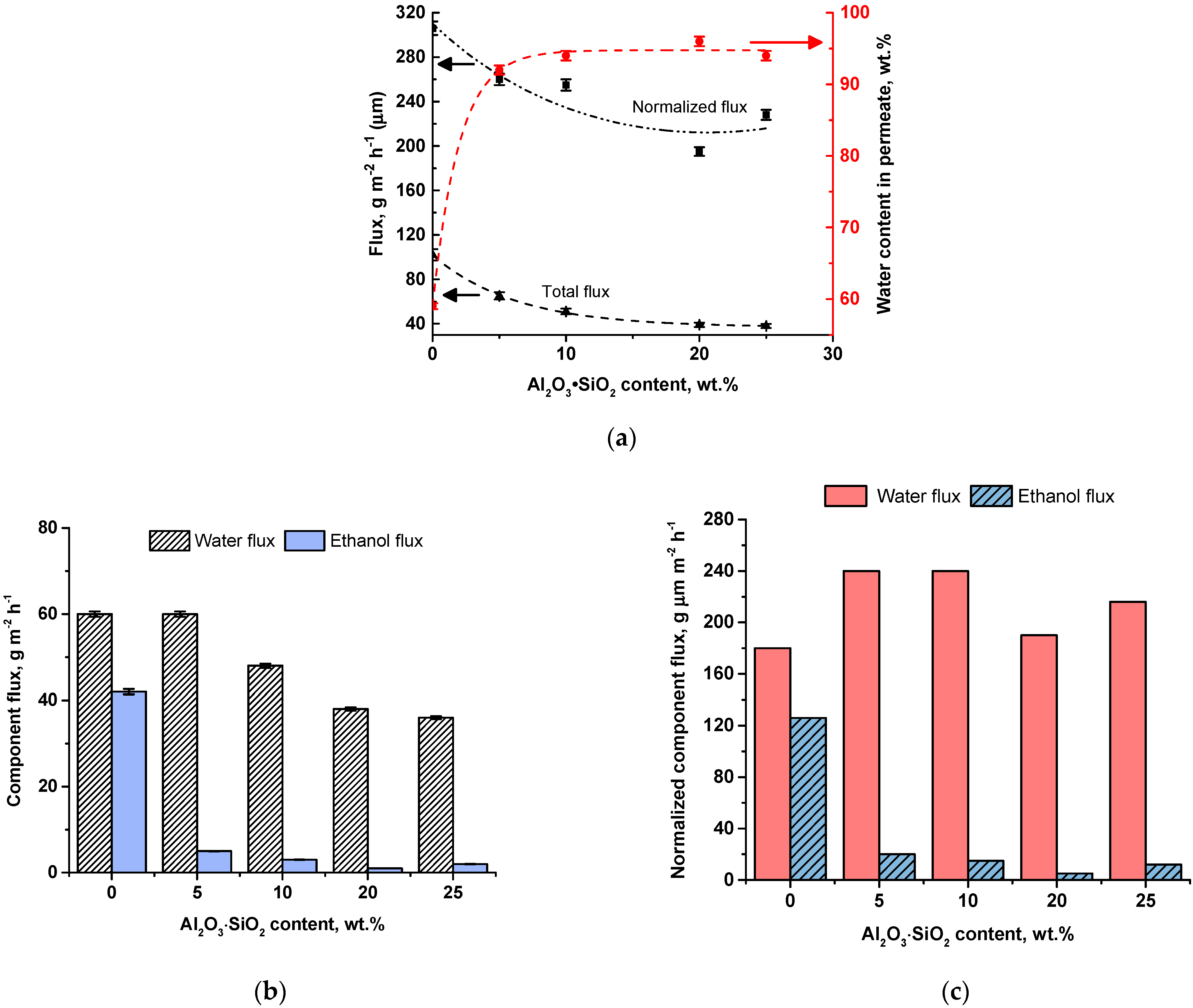

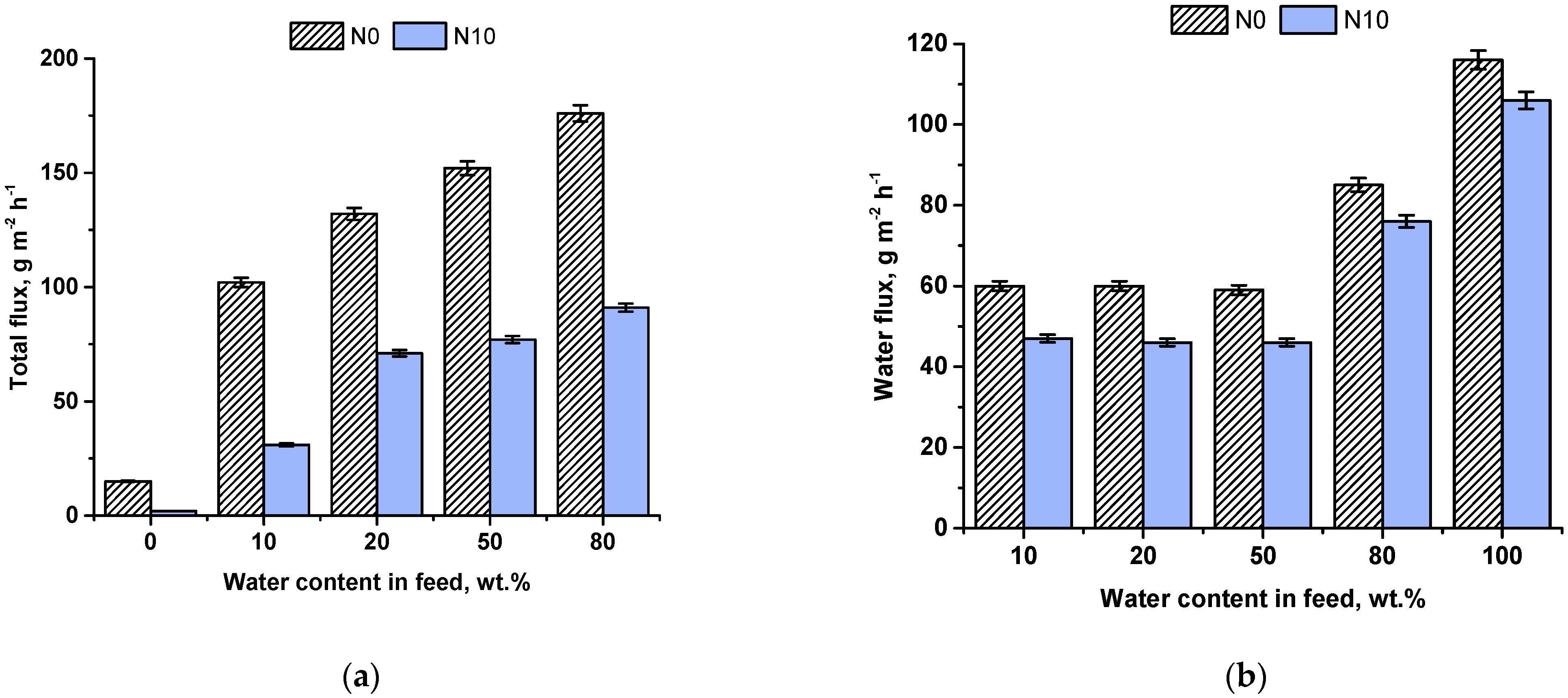
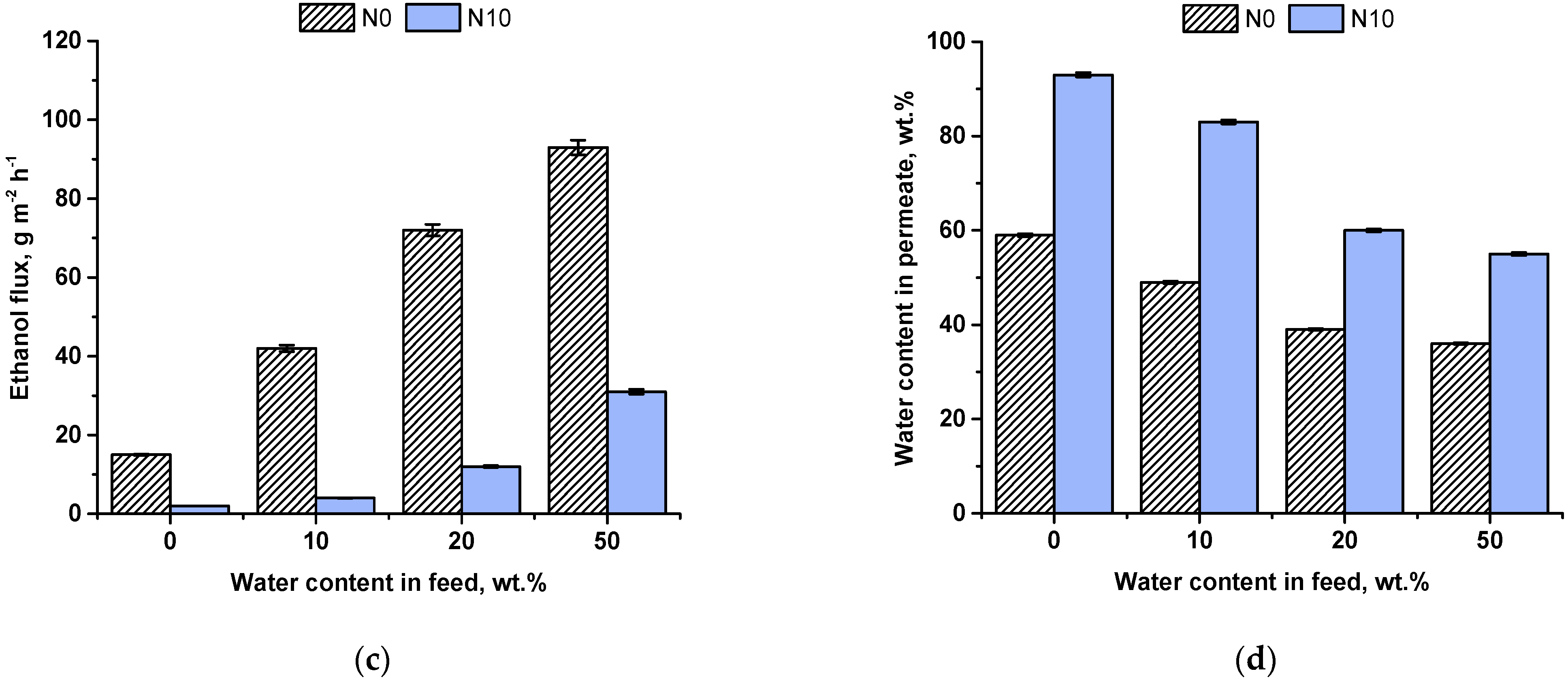
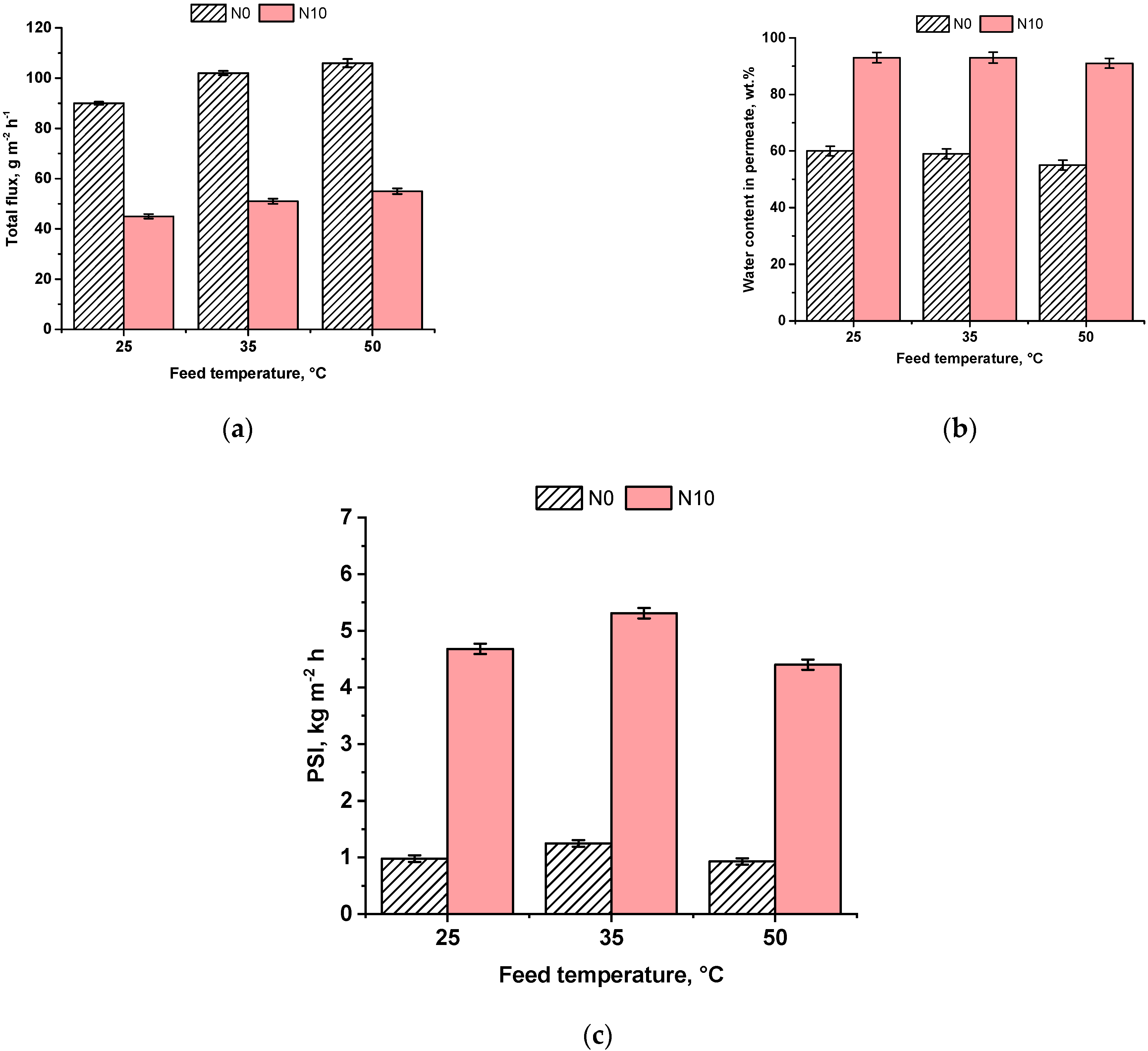
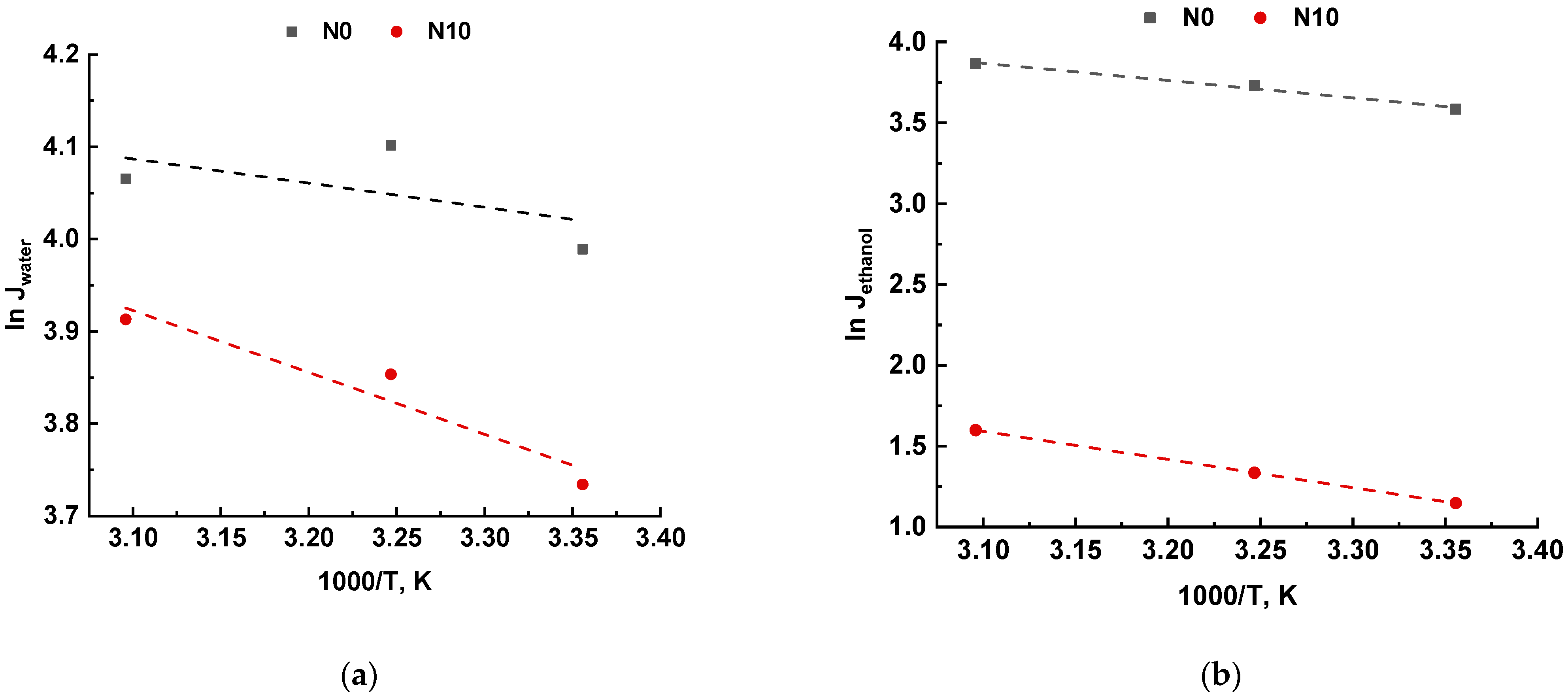
| Al2O3·SiO2 Content, wt.% of PVA Weight | Particle Size, nm | Zeta Potential, mV |
|---|---|---|
| 5 | 118 | −3.92 |
| 10 | 142 | −3.33 |
| 20 | 179 | −3.31 |
| 25 | 186 | −3.71 |
| Membrane Designation | Ra, nm | Rq, nm |
|---|---|---|
| N0 | 0.59 | 0.76 |
| N5 | 1.20 | 1.50 |
| N10 | 0.80 | 0.93 |
| N20 | 0.93 | 1.20 |
| N25 | 0.80 | 0.97 |
| Membrane Designation | Water Contact Angle, ° |
|---|---|
| N0 | 78 |
| N5 | 74 |
| N10 | 71 |
| N20 | 69 |
| N25 | 58 |
| Membrane Designation | Eapp (Water), J mol−1 | Eapp (Ethanol), J mol−1 |
|---|---|---|
| N0 | 2.18 | 8.91 |
| N10 | 5.58 | 14.47 |
| Membranes | Selective Layer Thickness [µm] | Mixture | Water Content in Feed [wt.%] | Temperature [°C] | Permeation Flux [g m−2 h−1] | Water Content in Permeate [wt.%] | Reference |
|---|---|---|---|---|---|---|---|
| PVA-20 wt.%SiO2/PAN support | 6 | Ethanol/water | 10 | 34 | 44 | 89 | [20] |
| PVA-2.5 wt.% sodium aluminasilicate | 25 | 1,4-dioxane-water | 10 | 30 | 150 | 85 | [57] |
| PVA-15 wt.%SiO2/PAN support | 25 | Ethanol/water | 10 | 60 | 1193 | 78.5 | [64] |
| Sodium alginate—15 wt.% magnesium aluminum silicate particles | - | Isopropanol/water | 10 | 30 | 56 | 99.95 | [55] |
| PVA-3 wt.% Fe(II)/Fe(III)/polyester fabrics | - | Isopropanol/water | 10 | 30 | 82 | 94 | [65] |
| PVA-Al2O3·SiO2/PAN | 5 | Ethanol/water | 10 | 35 | 51 | 94 | This work |
| Membrane Designation | Al2O3·SiO2 Content, wt.% of PVA Weight |
|---|---|
| N0 | 0 |
| N5 | 5 |
| N10 | 10 |
| N20 | 20 |
| N25 | 25 |
Publisher’s Note: MDPI stays neutral with regard to jurisdictional claims in published maps and institutional affiliations. |
© 2022 by the authors. Licensee MDPI, Basel, Switzerland. This article is an open access article distributed under the terms and conditions of the Creative Commons Attribution (CC BY) license (https://creativecommons.org/licenses/by/4.0/).
Share and Cite
Burts, K.S.; Plisko, T.V.; Prozorovich, V.G.; Melnikova, G.B.; Ivanets, A.I.; Bildyukevich, A.V. Modification of Thin Film Composite PVA/PAN Membranes for Pervaporation Using Aluminosilicate Nanoparticles. Int. J. Mol. Sci. 2022, 23, 7215. https://doi.org/10.3390/ijms23137215
Burts KS, Plisko TV, Prozorovich VG, Melnikova GB, Ivanets AI, Bildyukevich AV. Modification of Thin Film Composite PVA/PAN Membranes for Pervaporation Using Aluminosilicate Nanoparticles. International Journal of Molecular Sciences. 2022; 23(13):7215. https://doi.org/10.3390/ijms23137215
Chicago/Turabian StyleBurts, Katsiaryna S., Tatiana V. Plisko, Vladimir G. Prozorovich, Galina B. Melnikova, Andrei I. Ivanets, and Alexandr V. Bildyukevich. 2022. "Modification of Thin Film Composite PVA/PAN Membranes for Pervaporation Using Aluminosilicate Nanoparticles" International Journal of Molecular Sciences 23, no. 13: 7215. https://doi.org/10.3390/ijms23137215
APA StyleBurts, K. S., Plisko, T. V., Prozorovich, V. G., Melnikova, G. B., Ivanets, A. I., & Bildyukevich, A. V. (2022). Modification of Thin Film Composite PVA/PAN Membranes for Pervaporation Using Aluminosilicate Nanoparticles. International Journal of Molecular Sciences, 23(13), 7215. https://doi.org/10.3390/ijms23137215










